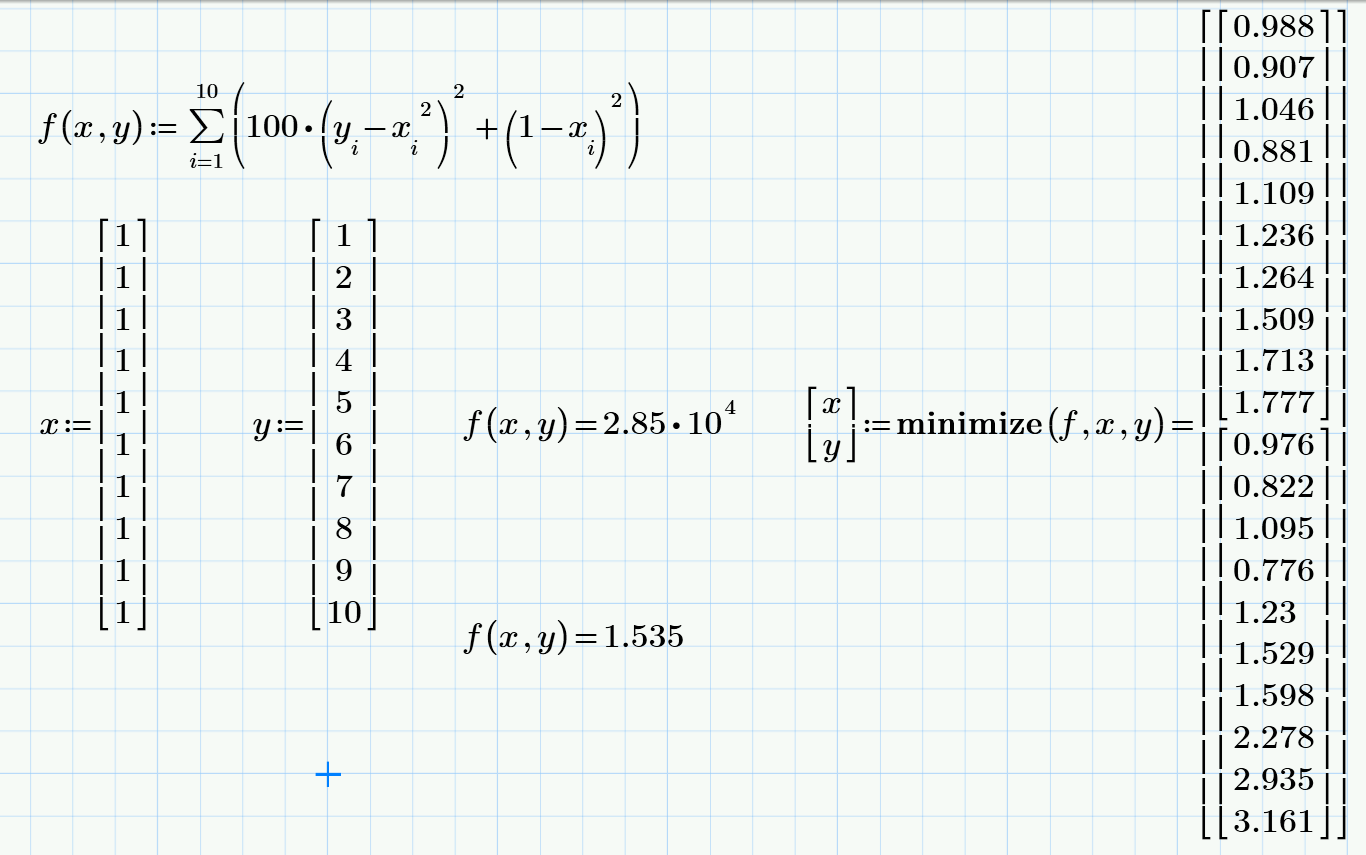Community Tip - Visit the PTCooler (the community lounge) to get to know your fellow community members and check out some of Dale's Friday Humor posts! X
- Subscribe to RSS Feed
- Mark Topic as New
- Mark Topic as Read
- Float this Topic for Current User
- Bookmark
- Subscribe
- Mute
- Printer Friendly Page
Available in the Mathcad tools do not allow to find the minimum of a function constructed from 10 Rosenbrock functions.
- Mark as New
- Bookmark
- Subscribe
- Mute
- Subscribe to RSS Feed
- Permalink
- Notify Moderator
Available in the Mathcad tools do not allow to find the minimum of a function constructed from 10 Rosenbrock functions.
I'm looking for a ready-made algorithm "Direct search" (D.M. Himmelblau, Appled Nonlinear Programming, 1972) in Mathcad before 14. Is there such anyone? Thanks in advance.
J. Reyzenkind.
Solved! Go to Solution.
Accepted Solutions
- Mark as New
- Bookmark
- Subscribe
- Mute
- Subscribe to RSS Feed
- Permalink
- Notify Moderator
Яков Рейзенкинд wrote:
f(x,y)= (100*(y1-x1^2)^2+(1-x1)^2)+(100*(y2-x2^2)^2+(1-x2)^2)+...+(100*(y10-x10^2)^2+(1-x10)^2)
This is a test function .
Perhaps the attached worksheet may be worth looking at; it uses the Hooke-Jeeves method.
Stuart
Modified version of worksheet posted in thread Hooke-Jeeves function TOMS178
- Mark as New
- Bookmark
- Subscribe
- Mute
- Subscribe to RSS Feed
- Permalink
- Notify Moderator
Some time ago there was a similar topic, here: Want to write MathCAD programm based on Maple 13 Code . Perhaps Walter has found a solution to this problem, try to ask him by using private message.
- Mark as New
- Bookmark
- Subscribe
- Mute
- Subscribe to RSS Feed
- Permalink
- Notify Moderator
Vladimir, thanks for the tip!
- Mark as New
- Bookmark
- Subscribe
- Mute
- Subscribe to RSS Feed
- Permalink
- Notify Moderator
No problem.
Just note that in addition to the implementation of this algorithm in Maple there is a whole toolbox in MATLAB (is called "Genetic Algorithm and Direct Search Toolbox"):
MATLAB Central - MathWorks - Genetic Algorithm and Direct Search Toolbox -
Genetic Algorithm and Direct Search Toolbox - Математика - Matlab.Exponenta.Ru
- Mark as New
- Bookmark
- Subscribe
- Mute
- Subscribe to RSS Feed
- Permalink
- Notify Moderator
Vladimir! Thanks again.
- Mark as New
- Bookmark
- Subscribe
- Mute
- Subscribe to RSS Feed
- Permalink
- Notify Moderator
- Mark as New
- Bookmark
- Subscribe
- Mute
- Subscribe to RSS Feed
- Permalink
- Notify Moderator
Dear Valery!
Thanks for sending the link. I ran the genetic algorithm on the Rosenbrock function (100*(y-x^2)^2+(1-x)^2). It works reliably. But in my test case x and y are vectors containing the 10 components. Unfortunately, I don't know how to enter vectors. In addition, I believe that for the problem with at least one minimum direct search will be more effective than genetic algorithm.
All the best.
- Mark as New
- Bookmark
- Subscribe
- Mute
- Subscribe to RSS Feed
- Permalink
- Notify Moderator
Яков Рейзенкинд wrote: But in my test case x and y are vectors containing the 10 components.
???
Please show one example.
- Mark as New
- Bookmark
- Subscribe
- Mute
- Subscribe to RSS Feed
- Permalink
- Notify Moderator
f(x,y)= (100*(y1-x1^2)^2+(1-x1)^2)+(100*(y2-x2^2)^2+(1-x2)^2)+...+(100*(y10-x10^2)^2+(1-x10)^2)
This is a test function ![]() .
.
- Mark as New
- Bookmark
- Subscribe
- Mute
- Subscribe to RSS Feed
- Permalink
- Notify Moderator
Яков Рейзенкинд wrote:
f(x,y)= (100*(y1-x1^2)^2+(1-x1)^2)+(100*(y2-x2^2)^2+(1-x2)^2)+...+(100*(y10-x10^2)^2+(1-x10)^2)
This is a test function .
Perhaps the attached worksheet may be worth looking at; it uses the Hooke-Jeeves method.
Stuart
Modified version of worksheet posted in thread Hooke-Jeeves function TOMS178
- Mark as New
- Bookmark
- Subscribe
- Mute
- Subscribe to RSS Feed
- Permalink
- Notify Moderator
Яков Рейзенкинд wrote:
f(x,y)= (100*(y1-x1^2)^2+(1-x1)^2)+(100*(y2-x2^2)^2+(1-x2)^2)+...+(100*(y10-x10^2)^2+(1-x10)^2)
This is a test function .
It is a function with 20 argument?
May be in this direction:

- Mark as New
- Bookmark
- Subscribe
- Mute
- Subscribe to RSS Feed
- Permalink
- Notify Moderator
Valery Ochkov wrote:
Яков Рейзенкинд wrote:
f(x,y)= (100*(y1-x1^2)^2+(1-x1)^2)+(100*(y2-x2^2)^2+(1-x2)^2)+...+(100*(y10-x10^2)^2+(1-x10)^2)
This is a test function .
It is a function with 20 argument?
May be in this direction:
...<image> ...
Interesting. I get a different result using the Hooke-Jeeves algorithm;

The nested vector (3rd element of the result row vector) gives the co-ordinates whilst the last element of the result row vector gives the value of the Rosenbrock function at that location. (the first two values are the Rosenbrock value at the starting values and the number of iterations, respectively)
Stuart
- Mark as New
- Bookmark
- Subscribe
- Mute
- Subscribe to RSS Feed
- Permalink
- Notify Moderator
Stuart, Hello! Thank you very much for your materials. It will take time to understand them. All the best!
Jacob.
- Mark as New
- Bookmark
- Subscribe
- Mute
- Subscribe to RSS Feed
- Permalink
- Notify Moderator
Thank You!





